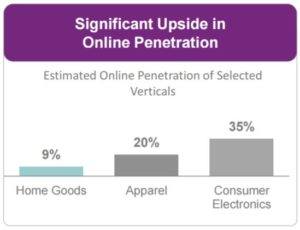Wayfair: Using AR and VR for Furniture Visualization

Wayfair Next is using AR and VR to accelerate the shift of home goods to e-commerce by exploring new forms of product visualization.
Wayfair is an e-commerce furniture and home décor retailer. The company has been built on a thesis that consumers want a lot of selection and variety for home furnishings, therefore it has amassed a catalog of over 8 million items for sale on its website from over 10,000 suppliers.[i] This huge catalog is made possible through drop shipping, in which the supplier of the product ships it directly to the consumer once a purchase has been made. Wayfair has grown to $3.4 billion in revenue while taking very little inventory.[ii]
The furniture and home décor category still has very low penetration in online shopping compared to other categories. Only 9% of home goods are purchased online compared to 20% for apparel and 35% for consumer electronics.[iii] The headroom for further penetration provides a huge opportunity for Wayfair. Critics are skeptical that furniture will ever reach the level of e-commerce penetration of these other categories because of the difficulty envisioning furniture in a room and without the ability to touch and feel the pieces before making the purchase decision. However, augmented reality and virtual reality can provide solutions to bridge this gap for Wayfair.
Wayfair Next
Wayfair launched an in-house research and development team called Wayfair Next in 2016 to accelerate the category shift to e-commerce by exploring new forms of product visualization.[iv] Wayfair Next is using technology to improve the online shopping experience for the Wayfair products. The team is working on three priorities: 1) 3D modeling and 2D renderings; 2) augmented reality; and 3) virtual reality.
1) 3D Modeling and 2D Renderings
3D modeling of products is the backbone of all three of the Wayfair Next priorities. Without 3D models of Wayfair’s product catalog, the products cannot be represented in AR or VR. In addition to these applications, Wayfair is also using 3D modeling in order to create 2D photos and imagery of the products for their website. With 3D models, Wayfair can create product images and full room lifestyle photos of furniture and décor without needing product samples, physical photo studios, or a photography and styling team. Wayfair has already begun using fully rendered photos on its website as images on the product page for some SKUs. Wayfair is capturing value through these 2D rendered images in the form of cost savings from photo shoots and product samples.
2) Augmented Reality
The 3D images are also driving the ability for customers to visualize products in their home using augmented reality. In 2016, Wayfair launched an augmented reality app, WayfairView, in the Google Play store available on Google Tango-enabled smartphones.[v] WayfairView allows customers to super-impose a product into a room of their home using the camera on their smartphone. Customers can move and rotate products to test layouts and view objects from all angles. Importantly, Wayfair is creating value for customers by allowing them to test out the look and fit of the product before making a purchase, solving a key pain point of shopping online for home goods.
3) Virtual Reality
Lastly, Wayfair has launched two virtual reality apps: 1) Patio Playground for Oculus Rift in August 2016[vi] and 2) IdeaSpace on Google Daydream in November 2016.[vii] These virtual reality apps allow customers to view home furnishing products together to test different styles in a virtual room or backyard. In the future, virtual reality could also enable Wayfair to have virtual showrooms, allowing customers to visit a Wayfair-branded store to browse products in virtual reality and potentially solve the touch barrier by allowing customers to feel the product either through swatches and samples or future tactile technologies.
Conclusion
Wayfair is utilizing augmented and virtual reality to improve the customer shopping and buying process for online furniture and home décor. These and future apps can help Wayfair differentiate themselves from their online and brick-and-mortar competitors, allowing Wayfair to capture more home goods market share and a large portion of the furniture sales moving online. The main challenges that remain are the low penetration of AR and VR devices, the limitation of the AR app to Google Tango-enable smartphones, and the backlog of Wayfair’s 8 million products that will need to be 3D modeled before being available in the AR and VR apps.
[i] Wayfair Investor Presentation, 4Q2016. http://s2.q4cdn.com/848638248/files/doc_presentations/2016NewFolder/W.Presentation_Q4-2016_vF.pdf
[ii] Ibid.
[iii] Ibid.
[iv] http://www.businesswire.com/news/home/20160511005150/en/Wayfair-Announces-Opening-Research-Development-Laboratory
[v] http://investor.wayfair.com/investor-relations/press-releases/press-releases-details/2017/Wayfairs-Augmented-Reality-App-Now-Available-on-the-Asus-Tango-Enabled-ZenFone-AR/default.aspx
[vi] http://investor.wayfair.com/investor-relations/press-releases/press-releases-details/2016/Wayfair-Launches-Virtual-Reality-App-to-Customize-Outdoor-Spaces-with-Furnishings-and-Dcor/default.aspx
[vii] http://investor.wayfair.com/investor-relations/press-releases/press-releases-details/2016/Wayfair-Unveils-Immersive-Home-Design-Experience-with-Daydream-Virtual-Reality-App/default.aspx
Note: I interned at Wayfair in the summer of 2016.





Natalie, great post! Love the topic. Quick question: how long do you think Wayfair has before Amazon takes over the market? Jk jk! 😛
Seriously though, I think AR in the furniture market will have a phenomenal impact. I do believe not being able to picture how furniture actually looks is the biggest barrier to online purchase. Wouldn’t it also be amazing if you could combine haptic feedback so that customers could virtually test how the furniture feels?
Great post, Nalatie. Can’t agree more with what Meili said (well 2 soon-to-be-Amazonians should always think good about Amazon!) that it’s not too far away when Amazon will take over. But I will add a third player to it: how about IKEA?
We have seen in multiple IKEA cases at HBS how their value proposition has always been to let a customer buy everything they need in one visit. But they lose on a lot of customers who are not able to travel to their far-off locations. Now imagine with the help of VR, all of them can access and order IKEA inventory. Starting with kitchen experience, they have also started to test out VR stores:
http://www.ikea.com/us/en/about_ikea/newsitem/040516_Virtual-Reality
How do you think the VR furniture industry will pan out?
Thanks for sharing, Natalie! I also thought about writing about Wayfair (surprise!) and found out in the process that they’re offering an API for third parties to retrieve and use the firm’s 3D furniture models: http://engineering.wayfair.com/2016/10/wayfairs-3d-model-api/. That blog post suggests a few potential applications for the API. Do you think they’re on the right track, or might they be leaving more valuable opportunities on the table?
Hey Natalie! I wonder what exactly can VR do for Wayfair – does it attract customers that otherwise wouldn’t buy furniture online, or does it differentiate them from other e-retailers in the eyes of people who are already going to buy furniture online? The former is growing the pie and the latter re-splits the pie. Anyway – interesting post!